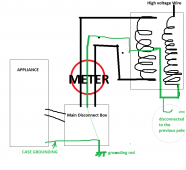burgerking
New Member
Assume:
Grid's Neutral is bonded to a Grounding Rod in the Main AC Disconnect
My electric gears are grounded (chassis are connected to a grounding wire to the grounding rod)
The neighborhood receives (High Leg) 3 Phase power from these two transformers. I assume the Right Transformer as 208V, Left Transformer as 120-0-120V. Green wire is Neutral; it runs from the very top of the electric poles to other electric poles.

Here is my problem:
Assume somewhere in the neighborhood the neutral wire leading to this electric post snapped!
These transformers will then have no true Neutral, and its only return path are the neighborhood's individual Grounding Rods.
Obviously our Grounding Rods do not provide perfect conduction for power; I suspect our "Ground Wires" would have higher potential than the ground we are standing.
What is the solution for this?
Grid's Neutral is bonded to a Grounding Rod in the Main AC Disconnect
My electric gears are grounded (chassis are connected to a grounding wire to the grounding rod)
The neighborhood receives (High Leg) 3 Phase power from these two transformers. I assume the Right Transformer as 208V, Left Transformer as 120-0-120V. Green wire is Neutral; it runs from the very top of the electric poles to other electric poles.

Here is my problem:
Assume somewhere in the neighborhood the neutral wire leading to this electric post snapped!
These transformers will then have no true Neutral, and its only return path are the neighborhood's individual Grounding Rods.
Obviously our Grounding Rods do not provide perfect conduction for power; I suspect our "Ground Wires" would have higher potential than the ground we are standing.
What is the solution for this?




